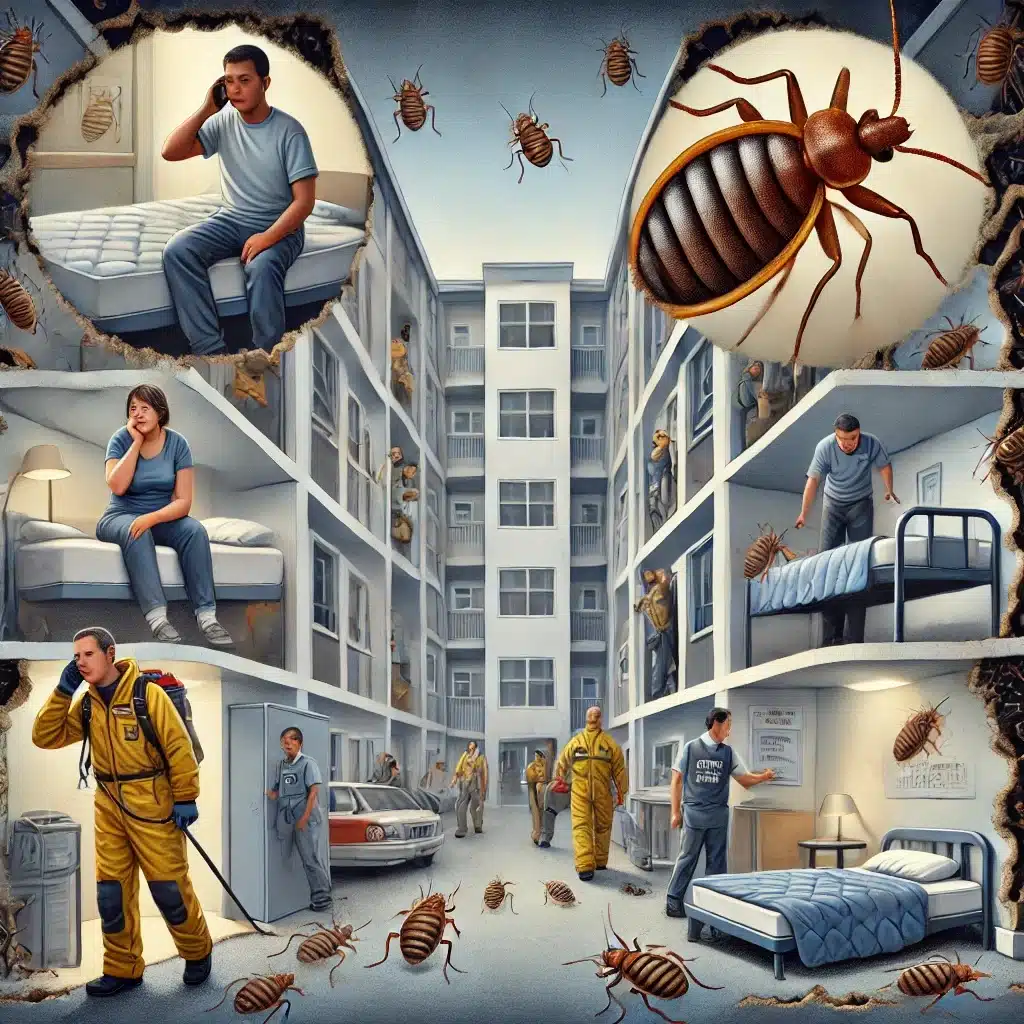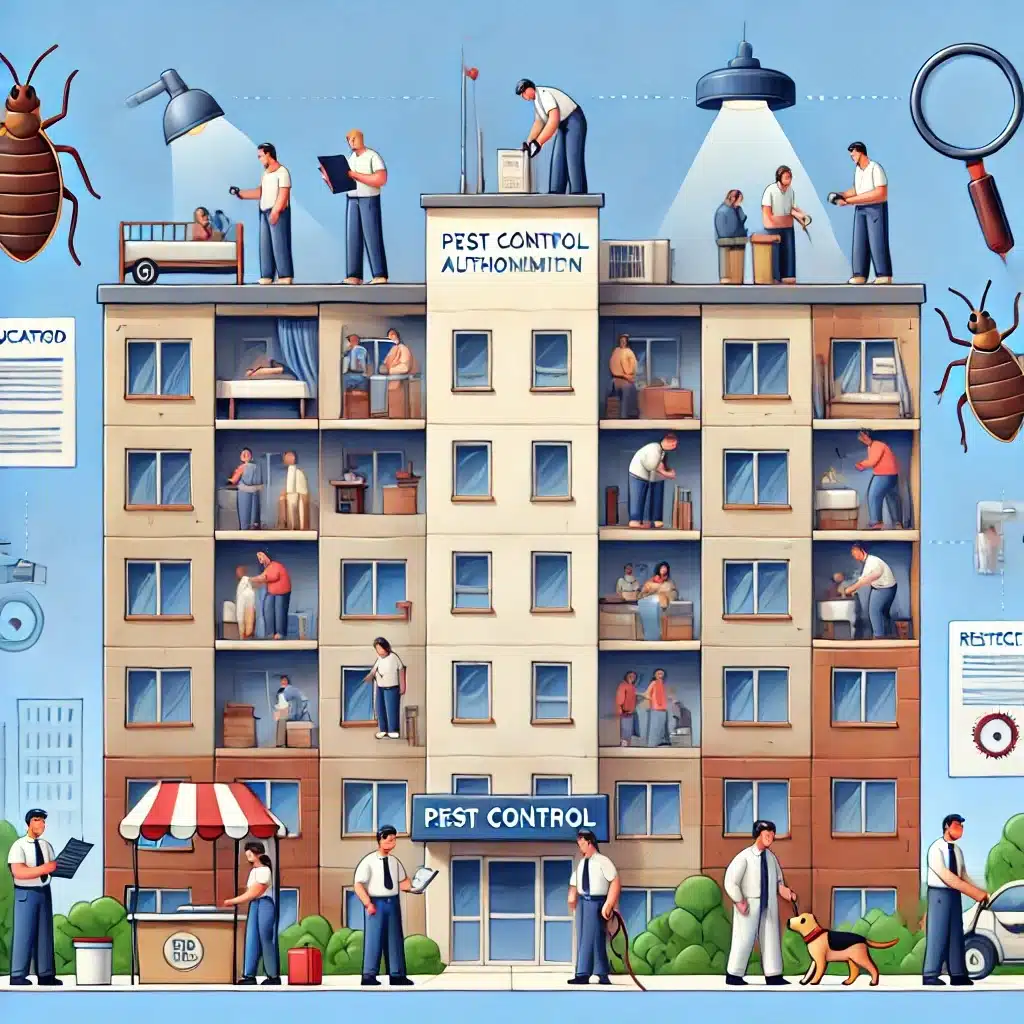By ThermoPest – Your Local Pest Control Experts
No one likes the thought of bed bugs in their home, but for residents in public housing, the problem can quickly become a reality. Bed bugs are notoriously hard to get rid of once they settle in, and in public housing, where people live in close quarters, infestations can spread like wildfire. It’s not just about the bites and sleepless nights—bed bug infestations can have far-reaching effects on both physical and mental health, as well as significant legal implications for housing authorities.
So, why do bed bugs thrive in public housing, and what can be done about it? Let’s break it down.

Why Bed Bugs Thrive in Public Housing
Public housing offers the perfect storm for bed bugs. Think about it: high population density, frequent turnover of tenants, shared walls, and lots of movement of furniture. All of these factors make it easy for bed bugs to spread from one flat to another. It doesn’t take much—someone unknowingly brings home a piece of furniture from a skip or buys a second-hand sofa, and suddenly, the whole building is at risk.
Unfortunately, it’s often the case that public housing is under-resourced. Housing authorities might not have the budget to deal with infestations quickly, and the problem can drag on. By the time pest control is called in, the infestation has spread, making it much more difficult (and expensive) to manage.
The Impact on Health and Wellbeing
Dealing with a bed bug infestation is more than just an inconvenience. For many residents, particularly those who are already vulnerable, bed bugs can cause real health issues. While bed bugs aren’t known to spread disease, their bites can cause allergic reactions, and scratching them can lead to skin infections. For those with weakened immune systems or existing skin conditions, this can be a serious concern.
Then there’s the mental toll. Anyone who has lived with bed bugs will tell you it’s not just about the bites—it’s about the constant anxiety. People start to dread going to bed, knowing they’ll wake up with new bites. It’s not uncommon for people to lose sleep, which only adds to the stress.
Children and elderly residents are especially at risk. Bed bug infestations can have a significant impact on the mental health of these groups, leading to increased anxiety and social isolation.
Challenges in Addressing Bed Bugs in Public Housing
One of the biggest challenges in public housing is getting a timely response to bed bug infestations. The bureaucratic process can be slow, and housing authorities might not have the resources to act as quickly as needed. Meanwhile, the infestation spreads, and more tenants are affected.
Stigma is another issue. Many residents are reluctant to report bed bugs for fear of being blamed or even evicted. There’s still a lot of misunderstanding around bed bugs—some people assume they only infest dirty homes, which isn’t true at all. Bed bugs don’t care if your house is clean or cluttered; they’re after one thing: blood.
Education is key here. Tenants need to understand how bed bugs spread and how to prevent them. But housing authorities also need to do their part by responding quickly and providing adequate pest control services when an infestation is reported.
Legal Obligations for Housing Authorities
This is where things can get tricky. In many places, housing authorities have a legal responsibility to maintain habitable living conditions for their tenants. That means if a bed bug infestation makes a home unliveable, the housing authority could be held liable. Tenants have the right to live in a pest-free environment, and if housing authorities fail to act, they could face legal consequences.
For tenants, this means they can demand action if bed bugs are a persistent problem. In some cases, tenants may even be able to withhold rent until the issue is resolved or take the matter to court. Housing authorities, on the other hand, need to ensure they are taking reasonable steps to prevent and address infestations. This includes regular inspections, timely pest control, and, crucially, communicating clearly with tenants about what’s being done.
Effective Strategies for Managing Bed Bugs in Public Housing
So, what’s the solution? The key to managing bed bug infestations in public housing is early detection and a proactive approach. Regular inspections can help catch infestations before they become widespread, and early detection methods—like bed bug detection dogs—can help find pests in hard-to-reach places.
Integrated Pest Management (IPM) is a strategy that’s proving highly effective. IPM focuses on long-term prevention through a combination of methods, including regular monitoring, education, and targeted treatments. It’s about more than just spraying chemicals—it’s about working with the environment and the tenants to keep infestations under control.
Tenants also have a role to play. Simple steps like avoiding second-hand furniture, regularly checking for signs of bed bugs, and reporting any problems immediately can make a big difference in preventing the spread of bed bugs in public housing.
Case Studies and Success Stories
There have been several successful examples of bed bug management in public housing, proving that with the right approach, the problem can be controlled. In some housing complexes, regular inspections combined with tenant education have significantly reduced the number of infestations. In other cases, authorities have implemented community-wide pest control initiatives, treating entire buildings to prevent the bugs from simply moving from one flat to another.
These success stories highlight the importance of a proactive, community-focused approach. When housing authorities, pest control professionals, and tenants work together, bed bugs don’t stand a chance.

Wrapping Up: Why Prevention and Professional Help Matter
Bed bug infestations in public housing can have serious consequences for residents’ health, wellbeing, and quality of life. The economic cost is high too, with housing authorities potentially facing legal action if they fail to deal with the problem effectively. That’s why early intervention is so important. By acting quickly and working with professional pest control services like ThermoPest, housing authorities can prevent infestations from spreading and improve living conditions for their tenants.
If you’re dealing with bed bugs, whether in public housing or a private residence, don’t wait for the problem to get worse. Give ThermoPest a call today, and let us help you get back to living in a comfortable, pest-free home.
